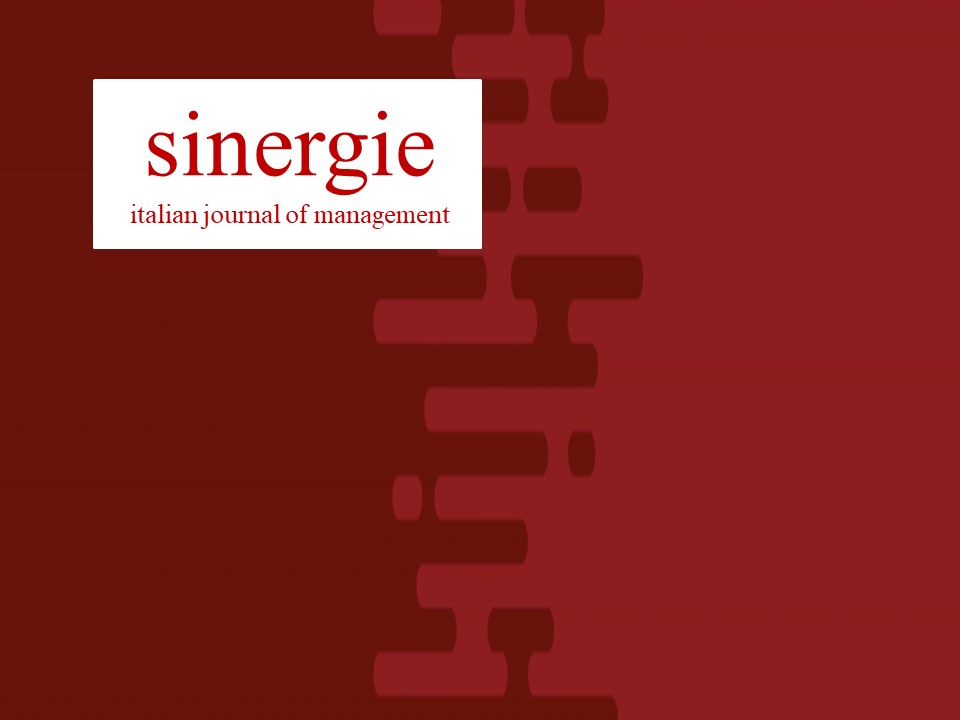Fattori influenti sul ricorso ad Internet nei processi gestionali delle micro-imprese
Obiettivo del paper: Il presente lavoro intende offrire un contributo di conoscenza sul rapporto tra piccole imprese e Internet, analizzando in particolare i principali fattori influenti sulla decisione di utilizzare tale tecnologia nei processi di management da parte delle micro-imprese artigiane.
Metodologia: Dopo unanalisi della letteratura, stato costruito un modello di ricerca e sono state elaborate quattro ipotesi (sottoposte successivamente ad una verifica empirica su un campione di 600 imprese marchigiane), relative ad altrettanti fattori, consideranti rilevanti in letteratura ai fini del ricorso o meno ad Internet: dimensione aziendale, localizzazione geografica, settore economico di appartenenza e ampiezza del mercato di vendita dellimpresa.
Risultati: Dallanalisi statistica svolta emerso che la diffusione di Internet nelle imprese indagate ancora piuttosto bassa, e che la decisione di utilizzare tale tecnologia influenzata dalla dimensione dellimpresa e dal settore, ma non dalla localizzazione.
Limiti della ricerca: I risultati presentati costituiscono la prima fase di un processo di ricerca piampio, volto ad indagare anche le modalitdi utilizzo di Internet e le connesse implicazioni per la competitivitdelle imprese.
Implicazioni pratiche: Il paper evidenzia i limiti delladozione di Internet nelle micro-imprese, cercando di individuarne le cause, dalle quali possono derivare utili indicazioni manageriali per il miglioramento della competitivitaziendale.
Originalitdel lavoro: Pochi sono gli studi aventi per oggetto le micro-imprese artigiane, che pure rivestono unimportanza economica rilevante nel nostro Paese e in Europa; il presente lavoro intende contribuire a colmare tale gap, per comprendere le determinanti e le implicazioni di Internet in questa particolare tipologia di imprese.
Riferimenti bibliografici
ALAM S.S. (2009), Adoption of Internet in Malaysian SMEs, Journal of Small Business and Enterprise Development, vol. 16, n. 2, pp. 240-255.
ARBORE A., ORDANINI A. (2006), Broadband divide among SMEs. The role of size, location and outsourcing strategies, International Small Business Journal, vol. 24, n. 1, pp. 83-99.
BAYO-MORIONES A., LERA-LOPEZ F. (2007), A firm-level analysis of determinants of ICT adoption in Spain, Technovation, vol. 27, n. 6-7, pp. 352-366.
BENGTSSON M., BOTER H., VANYUSHYN V. (2007), Integrating the Internet and marketing operations. A study of antecedents in firms of different size, International Small Business Journal, vol. 25, n. 1, pp. 27-48.
BORDONABA-JUSTE V., LUCIA-PALACIO L., POLO-REDONDO Y. (2012), The influence of organizational factors on e-business use: analysis of firm size, Marketing Intelligence & Planning, vol. 30, n. 2, pp. 212-229.
BRYNJOLFSSON E. (1993), The productivity paradox of information technology, Communications of the ACM, vol. 36, n. 12, pp. 66-77.
CALDEIRA M.M., WARD J.M. (2003), Using resource-based theory to interpret the successful adoption and use of information systems and technology in manufacturing small and medium-sized enterprises, European Journal of Information Systems, vol. 12, pp. 127-141.
CEDROLA E. (2009), Internet per le piccole e medie imprese: potenzialit e stato dellarte in Italia e in Europa, Mercati e Competitivit, n. 1, pp. 20-43.
CENTRO STUDI CNA (2012), Le imprese, nonostante tutto.
CHEUNG W.M., HUANG W. (2002), An investigation of commercial usage of the World Wide Web: a picture from Singapore, International Journal of Information Management, vol. 22, n. 5, pp. 377-388.
DANDRIDGE T., LEVENBURG N.M. (2000), High-tech potential? An exploratory study of very small firms usage of the Internet, International of Small Business Journal, vol. 18, n. 2, pp. 81-91.
DAVIS P.S., HARVESTON P.D. (2000), Internationalization and organizational growth: the impact of Internet usage and technology involvement among entrepreneur-led family business, Family Business Review, vol. XIII, n. 2, pp. 107-120.
DAVIS C.H., VLADICA F. (2006), Use of Internet technologies and e-Business solutions: a structural model of sources of business value among Canadian micro-enterprises, Proceedings of the 39th Hawaii International Conference on System Science, Jan. 04-07, Kauai, USA.
DHOLAKIA R.R., KSHETRI N. (2004), Factors impacting the adoption of the Internet among SMEs, Small Business Economics, vol. 23, n. ???, pp. 311-322.
DRENNAN J., MCCOLL-KENNEDY J.R. (2003), The relationship between Internet use and perceived performance in retail and professional service firms, Journal of Service Marketing, vol. 17, n. 3, pp. 295-311.
DREW S. (2003), Strategic use of e-commerce by SMEs in the East of England, European Management Journal, vol. 21, n. 1, pp. 79-88.
FILLIS I., JOHANNSON U., WAGNER B. (2004), Factors impacting on e-business adoption and development in the smaller firm, International Journal of Entrepreneurial Behavior & Research, vol. 10, n. 3, pp. 178-191.
FILLIS I., WAGNER B. (2005) E-business Development: An Exploratory Investigation of the Small Firm, International Small Business Journal, vol. 23, n.6, pp. 604-634.
GOLINELLI G. (2009), Lapproccio sistemico-vitale: nuovi orizzonti di ricerca per il governo dellimpresa, Sinergie, n. 79, pp. XI-XXIV.
GOLINELLI G., GATTI M. (2007), Il pensiero di Roberto Fazzi e lapproccio sistemico al governo dellimpresa: spunti di riflessione tra debito culturale, avanzamento dottrinale e spirito del tempo, Sinergie, n. 72, pp. 207-255.
GRANDON E.E., PEARSON J.M. (2004), Electronic commerce adoption: an empirical study of small and medium US business, Information and Management, vol. 42, n. 1, pp. 197-216.
GREGORI G.L., CARDINALI S., TEMPERINI V. (2012), Traiettorie di sviluppo delle imprese calzaturiere nel nuovo contesto competitivo, Giappichelli, Torino.
HAIRUDDIN H., NOR LAILA MD. N., ARIFF MD AB M. (2012), Why do microenterprise refuse to use information technology: a case of Batik microenterprises in Malaysia, in Procedia – Social and Behavioral Sciences, International Conference on Asia Pacific Business Innovation and Technology Management, vol. 57, pp. 494-502.
HOLLENSTEIN H. (2004), Determinants of the adoption of information and communication technologies. An empirical analysis based on firm-level data for the Swiss business sector, Structural Change and Economic Dynamics, vol. 15, n. 3, pp. 315-342.
IHLSTROM C., NILSSON M. (2003), E-business adoption by SMEs – prerequisites and attitudes of SMEs in a Swedish network, Journal of Organizational Computing and Electronic Commerce, vol. 13, n. 3/4, pp. 211-223.
JOHNSTON D.A., WADE M., MCCLEAN R. (2007), Does e-Business matter to SMEs? A comparison of the financial impacts of Internet business solutions on Europe and North American SMEs, Journal of Small Business Management, vol. 45, n. 3, pp. 354-361.
JUTLA D., BODORIK P., DHALIWAL J. (2002), Supporting the e-business readiness of small and medium-sized enterprises: approaches and metrics, Internet Research: Electronic networking applications and policy, vol. 12, n. 2, pp. 139-164.
KHEMTHONG S., ROBERTS L.M. (2006), Adoption of Internet and web technology for hotel marketing: a study of hotels in Thailand, Journal of Business Systems, Governance and Ethics, vol. 1, n. 2, pp. 47-60.
KOWTHA N.R., CHOON T.W. (2001), Determinants of website development: a study of electronic commerce in Singapore, Information and Management, vol. 39, n. 3, pp. 227-242.
LERTWONGSATIEN C.,WONGPINUNWATANA N. (2003). E-commerce adoption in Thailand: An empirical study of Small and Medium Enterprises (SMEs). Journal of Global Information Technology Management, vol. 6, n. 3, pp. 67-83.
LEVENBURG N.M. (2005), Does size matters? Small firms use of e-business tools in the supply chain, Electronic Markets, vol. 15, n. 2, pp. 94-105.
LEVY M., POWELL P., WORRALL L. (2005), Strategic Intent and E-business in SMEs: enablers and inhibitors, Information Resources Management Journal, vol. 18, n. 4, pp. 1-20.
LOVE P.E.D., IRANI Z., STANDING C., LIN C., BURN J.M. (2005), The enigma of evaluation: benefits, costs and risks of IT in Australian small-medium-sized enterprises, Information & Management, vol. 42, n. 1, pp. 947-964.
MOSTAFA R.H.A., WHEELER C., JONES M.V. (2005), Entrepreneurial orientation, commitment to the Internet and export performance in small and medium sized exporting firms, Journal of International Entrepreneurship, vol. 3, n. 4, pp. 291-302.
PARKER C.M., CASTLEMAN T. (2007), New directions for research on SME-eBusiness: insights from an analysis of journal articles from 2003 to 2006, Journal of Information Systems and Small Business, vol. 1, n. 1-2, pp. 21-40.
PASCUCCI F. (2012), Il web, il marketing e la crisi: prime riflessioni su alcuni casi aziendali in Franco M., Gregori G.L., Marcone M.R. (a cura di), Le opportunit oltre la crisi. Prospettive manageriali e strategie pubbliche dei Paesi dellEuropa del Sud, Societ Editrice Esculapio, Bologna, pp. 171-192.
PELTIER J.W., ZHAO Y., SCHIBROWSKU J.A. (2012), Technology adoption by small business: an exploratory study of the interrelationships of owner and environmental factors, International Small Business Journal, vol. 30, n. 4, pp. 406-431.
PONTIKAKIS D., LIN Y., DEMIRBAS D. (2006), History matters in Greece: the adoption of Internet-enabled computers by small and medium sized enterprises, Information Economics and Policy, vol. 18, n. 3, pp. 332-358.
POON S. (2000), Business environment and Internet commerce benefits – Small business perspective, European Journal of Information Systems, vol. 9, n. 2, pp. 72-81.
POON S., SWATMAN P.M.C. (1999), An exploratory study of small business Internet commerce issues, Information & Management, vol. 35, n. 1, pp. 9-18.
PREMKUMAR G., RAMAMURTHY D. (1995), The role of interorganizational and organizational factors on the decision mode for adoption on interorganizational systems, Decision Sciences, vol. 26, n. 3, p. 303-336.
PREMKUMAR, G. AND ROBERTS, M. (1999). Adoption of New Information Technologies in Rural Small Businesses. Omega: The International Journal of Management Science, vol. 27, pp 467-484.
SILVESTRELLI S. (2008), International Marketing Mix, Societ Editrice Esculapio, Bologna.
TAN K.S., CHONG S.C., LIN B., EZE U.C. (2010), Internet-based ICT adoption among SMES: demographic versus benefits, barriers, and adoption intention., Journal of Enterprise Information Management,vol. 23, n. 1, pp. 27-55.
THE BOSTON CONSULTING GROUP (2011), Fattore Internet. Come Internet sta trasformando leconomia italiana.
THONG J.Y.L., YAP C.S. (1995), CEO characteristics, organizational characteristics and information technology adoption in small business, Omega, vol. 23, n. 4, pp. 429-442.
VESCOVI T., IESEPPON G. (2002), Levoluzione di Internet come strumento di comunicazione e di marketing nelle imprese minori, Micro & Macro Marketing, anno XI, n. 3, pp. 509-521.
WADE M., JOHNSTON D., MCCLEAN R. (2004), Exploring the net impact of internet business solution adoption on SME performance, International Journal of Electronic Business, vol. 2, n. 4, pp. 336-350.
WALCZUCH R., VAN BRAVEN G., LUNDGREN H. (2000), Internet adoption barriers for small firms in the Netherlands, European Management Journal, vol. 18, n. 5, pp. 561-572.


